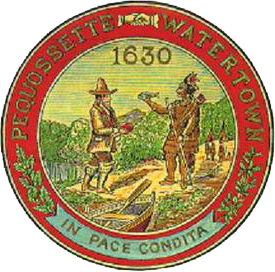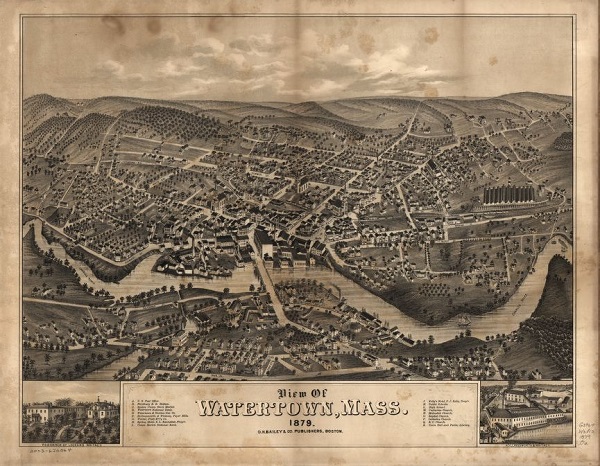Watertown is one of the oldest towns in Massachusetts. It was first settled by members of the Winthrop fleet in the summer of 1630 before being incorporated into the Massachusetts Bay Colony in the fall.
The following is a timeline of the history of Watertown:
7000 B.C.
- Humans begin visiting Watertown but do not establish a continuous settlement in the area.
1630:
- In July, Sir Richard Saltonstall and Reverend George Phillips and others from the Winthrop fleet row up the river from Charlestown and settle Watertown.
- In September, the settlement is officially incorporated into the Massachusetts Bay Colony as Watertown.
1634:
- A grist mill is built on the Charles River in Watertown.
1640:
- A wooden footbridge is built on what is now the site of the Galen Street Bridge.
1648:
- The wooden footbridge is expanded to accommodate horses.
1665:
- The Old Burying Ground is established on what is now modern day Arlington Street.
1694:
- The Abraham Browne House is built on Main Street.
1754:
- The Common Street Cemetery is established on Common Street.
- Part of Watertown is annexed to Cambridge.
1772:
- The Edmund Fowle Jr House is built on Marshal Street.
1776:
- From July to September, the Edmund Fowle House serves as the headquarters for the executive branch of the Massachusetts government.
- On July 19, the Treaty of Watertown is signed at the Edmund Fowle House. The treaty establishes a military alliance between the United States and the St. John’s Indians and some of the Mi’kmaw bands against Great Britain in the Revolutionary War.
1816:
- The Watertown Arsenal is established.
1818:
- The Levi Thaxter House is built on Main Street in what is now Saltonstall Park.
1820:
- The Bemis Textile Mill is built on Pleasant Street.
- The Reverend Convers Francis Home, a Federal-style house, is built on Riverside Street.
1830:
- The Russell House, a Greek Revival-style house, is built on Common Street.
1831:
- The Mount Auburn Cemetery is established on Mount Auburn Street.
1835:
- The Gore Place Farmhouse is built on Gore Street.
1840:
- The Silas M. Bates Shirt Factory is built on Spring Street.
- The Hastings House is built on Stearns Road.
- The Samuel Noyes House, a Federal-style house, is built on Green Street on the site of the former hotel owned by Colonel Elisha Stratton.
- The population of Watertown is 1,810.
1845:
- The Forbes House is built on Patten Street.
1848:
- St. Patrick’s Hall is built on Church Hill Street.
1850:
- The Tyler Bigelow House is built on Ladd Street.
- The population of Watertown is 2,837.
1856:
- The Pratt House, an Italianate-style house, is built on Mount Auburn Street.
1858:
- The Bigelow Chapel is built at the Mount Auburn Cemetery on Mount Auburn Street.
1860:
- The population of Watertown is 3,270.
1865:
- The Dalby Knitting Factory is built on Morse Street.
- The Commander’s Mansion is built on Talcott Ave for Major Thomas J. Rodman, the commanding officer for the Watertown Arsenal.
1866:
- The Soldier’s Monument is erected on Main Street.
1867:
- The Hollingsworth and Whitney Mill is built on Pleasant Street.
1870:
- The population of Watertown is 4,326.
1880:
- The population of Watertown is 5,426.
1882:
- The Levi Thaxter House is moved to the corner of Main Street and Cuba Street.
1884:
- The Watertown Free Public Library is built on Main Street.
- The Aetna Mill Worker Housing is built on Pleasant Street.
1888:
- Saint Patrick’s Roman Catholic Church School is built on Church Hill Street.
- Episcopal Church of the Good Shepherd is built on Russell Ave.
- The Historical Society of Watertown is founded by Dr. Alfred Hosmer, Rev. Edward Rand and Library Director Solon Whitney.
1889:
- Unitarian Parish House is built on Church Street.
- The Otis Building is constructed on Main Street.
1890:
- Saint Patrick’s Roman Catholic Rectory is built on Chestnut Street.
- The population of Watertown is 7,073.
1892:
- The Watertown Savings Bank is built on Main Street.
1894:
- St. John Methodist Episcopal Church & Parish Hall is built on Mount Auburn Street.
1895:
- The First Parish Church Meeting House Marker is erected on Mount Auburn Street.
1898:
- Mark’s Spring Street Pub is built on Spring Street.
1899:
- The First Baptist Church is built on Mount Auburn Street.
1900:
- The Rebecca Brigham Art Studio is built on Garfield Street.
- The Strand Theater is built on Galen Street.
- The Bailey Barn – Bailey Dye Works is built on Washburn Street.
- The population of Watertown is 9,766.
1901:
- Saint Patrick’s Roman Catholic Church is built on Main Street.
1910:
- The Watertown Arsenal – Sign Post is erected on Talcott Ave.
- The population of Watertown is 12,875.
1911:
- East End Fire Station is built on Mount Auburn Street.
1903:
- The Stanley Steam Vehicle Company building is constructed on Hunt Street.
1906:
- The Watertown Fire and Police Station is built on Main Street.
1907:
- The Marshall Spring Elementary School is built on Waverly Ave.
- The Galen Street Bridge is built on Galen Street.
1909:
- The Episcopal Church of the Good Shepherd Parsonage is built on Russell Ave.
1910:
- The Perkins School for the Blind is built on North Beacon Street.
1912:
- The Sacred Heart Roman Catholic Church is built on Mount Auburn Street.
1913:
- The Old Watertown High School is built on Mount Auburn Street.
1914:
- The George Washington Marker is established on Main Street.
- The Patten Street Bridge is built on Patten Street.
1920:
- The Union Market National Bank is built on Galen Street.
- The population of Watertown is 21,457.
1923:
- The Phillips Congregational Church Parish House is built on Mount Auburn Street.
- The Vose Piano Factory is built on Wooley Ave.
1924:
- The Saint Patrick’s High and Grammar School is built on Chestnut Street.
- The Minas S. Kondazian and Sons Men’s Suit Factory is built on Coolidge Hill Road.
- The Lewis-Shepard Machine Company is built on Walnut Street.
1925:
- Western Electric Company is built on Mount Auburn Street.
1928:
- The Watertown Savings Bank is built on Main Street.
1929:
- Stuart Crane Company is built on Philips Street.
1930:
- The Watertown West End Railway Substation is built on Cottage Street.
- The population of Watertown is 34,913.
1931:
- The Richard Saltonstall Statue is erected on Charlesbank Road.
1932:
- The Jacob Anteramian Upholstery and Barber Shop is built on Elm Street.
- The Watertown Administration Building is built on Main Street.
1935:
- Saint Joseph Hall is built at Rosary Academy on Rosary Drive.
1937:
- Phillips Congregational Church is built on Mount Auburn Street.
1938:
- Saint Theresa of the Child Jesus Catholic Church is built on Mount Auburn Street.
1940:
- The population of Watertown is 35,427.
1947:
- The town diner is built on Mount Auburn Street.
- Gatchell Glass Company Showroom is built on Arsenal Street.
- The Fire Station is built at the Watertown Arsenal on Arsenal Marketplace.
1949:
- The ‘Archangel’ Greek Orthodox Church is built on Bigelow Ave.
1950:
- The population of Watertown is 37,329.
1954:
- The Main Street Bridge is built over the B&M Railroad.
1960:
- The population of Watertown is 39,092.
1970:
- The population of Watertown is 39,307.
1980:
- The population of Watertown is 34,384.
1990:
- The population of Watertown is 33,284.
2000:
- The population of Watertown is 32,986.
2010:
- The population of Watertown is 31,915.
2013:
- On April 19, 2013, one of the Boston Marathon bombing suspects, Tamerlan Tsarnaev, is killed during a shoot out with police in Watertown while the other suspect, his brother Dzhokhar Tsarnaev, is injured but escapes on foot. He is captured eight hours later in Watertown.
Sources:
“Levi Thaxter House.” Digital Commonwealth, digitalcommonwealth.org/search/commonwealth:rv043575n
“Historical Houses.” Watertown, Ma – Official Websites, watertown-ma.gov/238/Historical-Houses
“Edmund Fowle House.” The Historical Society of Watertown, historicalsocietyofwatertownma.org/HSW/
“Did you know?” Watertown, Ma – Official Website, watertown-ma.gov/360/Did-You-Know
MACRIS, Massachusetts Multicultural Resource Information System, Massachusetts Historic Commission, mhc-macris.net/



